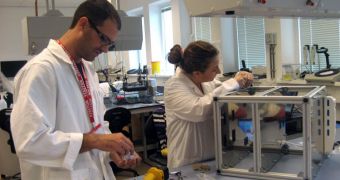The European Space Research and Technology Center (ESTEC), in Noordwijk, the Netherlands, is the home of the Large Diameter Centrifuge (LDC), a massive instrument that can be used to test various aspects related to high-gravity science for months on end.
The LDC, which was developed and funded by the European Space Agency (ESA), can be used for up to six months of non-stop spin at a time. It provides various levels of gravitational acceleration, ranging from 1 to 20G.
This area of science is called hypergravity, and it revolves around studying how biological organisms, geological samples, liquid droplets, and just about anything else, react to high gravity levels. The LDC can therefore be involved in studies conducted in numerous fields of science.
For example, one research team was especially interested in learning how ejecta plumes from meteorite and asteroid impacts on larger planet would behave in the atmosphere under hypergravity. LDC can now hold a total of 80 kilograms of scientific equipment.
Experiments can also be installed alongside its arms, providing a different level of gravity for each cargo. The centrifuge can also be accelerated while it's operating, therefore providing even more possibilities for scientists to fine-tune their studies.
“People propose all kinds of experiments – we assess them for scientific relevance, feasibility and safety. We perform physical, biological, geological and even astrogeological tests – one team investigated how crater impacts vary under higher gravity,” ESA expert Jutta Krause explains.
“In addition, the centrifuge is open for industrial users to test and qualify hardware. Last week, we hosted student teams from the latest round of ‘Spin your Thesis’, organized through ESA’s Education Office,” she goes on to say.
Once every six months, the centrifuge needs to be stopped for routine maintenance work, Jutta explains. Most experiments however do not require such long spin times. Some studies can be settled in as little as a few hours, or a few days.
“We’re interested in measuring changes to the angle of the droplets where their outside edge meets air. We’re performing 15-minute experiments across seven different g rates with liquids on various surfaces,” HyperDrop experiment team member Dmitry Zaitsev explains.
“It’s fairly fundamental research, but also has some practical applications. Spraying droplets onto surfaces is widely used in industry for cooling,” he concludes.

 14 DAY TRIAL //
14 DAY TRIAL //